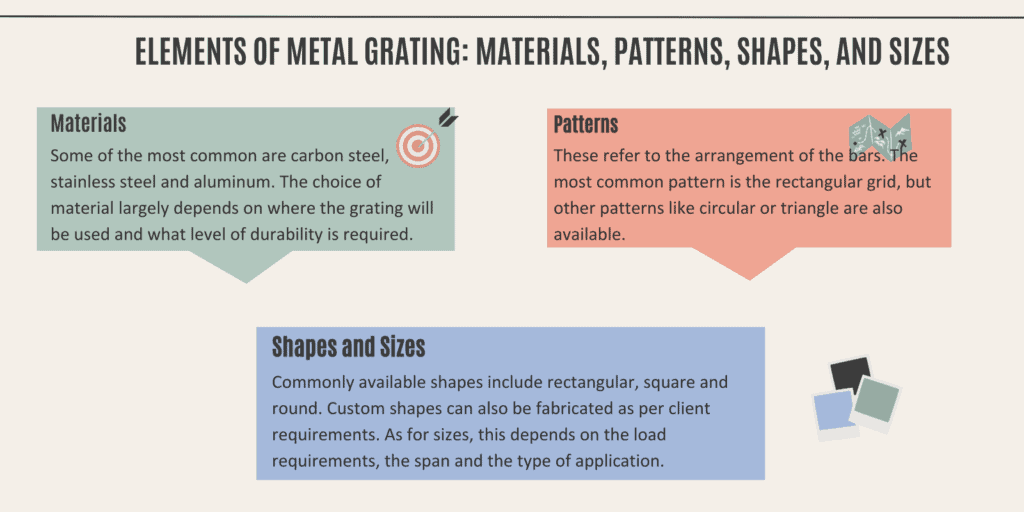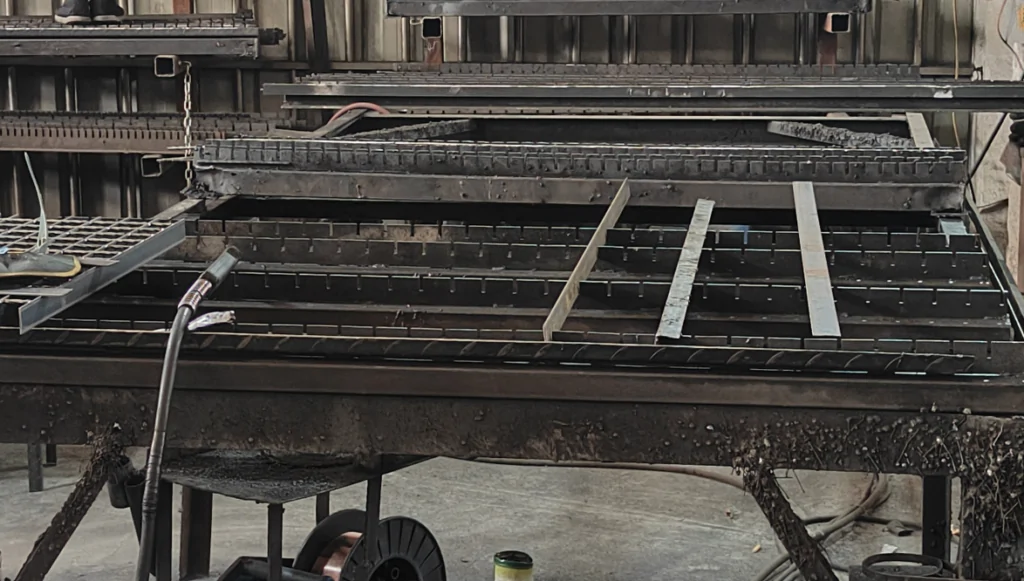Metal grating, essentially an assembly of metal bars strategically bonded together, is used to cover open spaces in floors, sidewalks or stairs. Its primary function is to provide a firm, safe surface to walk or transport materials upon, while enabling maximum passage for heat, light, air and moisture.
Its robustness and durability make it ideal for use in environments ranging from manufacturing plants to pedestrian sidewalks.
Continuing to delve into the world of metal grating will lead you to a greater understanding of its significance in our daily live. Let’s take a more in-depth look at how metal grating contributes to our safety and efficiency in the following segments.
I. Understanding Metal Grating

A. Definition of Metal Grating
Metal grating is a type of industrial product, made of steel, stainless steel or other hard metallic material, that is designed with regularly spaced bars, bearings and cross rods. Its main purpose is to provide strong support while allowing light, air, liquid and small debris to pass through.
With its robust and versatile characteristics, metal grating is widely applied in various industrial and architectural areas — from flooring on platforms, bridges, and stair steps, to screening on fences and dividers.
B. Different Types of Metal Grating
Expanding your knowledge on metal grating involves understanding its different types. Here are some of them:
- Welded Steel Grating: This type is probably the most commonly used due to its strength and economic value. It’s made by welding the bearing bar and cross rods at their intersection points.
- Swage-Locked Grating: This involves the use of a hydraulic swaging process which locks the cross rods into pre-punched holes in the bearing bars, creating a high strength joint.
- Riveted Grating: Riveted grating gets its name from the use of high-strength rivets to secure the bearing bars and cross rods. This type of grating is often used for heavy load applications.
- Pressure-locked Grating: In this type, the cross rods and bearing bars are notched and then locked together under high pressure. This results in a grating with high stability and uniformity.
C. Elements of Metal Grating: Materials, Patterns, Shapes, and Sizes
Understanding metal grating also entails familiarizing yourself with the different elements that make up its structure. These include the materials used, the patterns created, and the shapes and sizes available.

In conclusion, understanding metal grating is crucial for its proper selection and application. Having knowledge of its various types and elements helps in making informed choices when it comes to their usage.
II. The Making Process of Metal Grating

A. Overview of the Manufacturing Process
The manufacturing process of metal grating is a sophisticated art that involves a systematic and technical approach. This complex process starts with the chosen raw material, typically steel, aluminum, or stainless steel. The material then goes through several stages, including cutting, bending, and welding, all under meticulous supervision and control.
Quality assurance is a crucial part of the process, with multiple checks in place throughout the production line to ensure the accuracy and precision of the product. The finished metal grating is then treated with appropriate finishes depending on its intended use. This may include galvanizing and painting.
B. Different Techniques Used in Its Production
The production of metal grating involves a variety of techniques to deliver a product that meets the highest quality standards.
One common technique is press-locked grating, where bars are pressed into pre-punched holes in the bearing bars. This delivers a smooth and secure grating product.
Another method is forge-welding, which is commonly used for steel and stainless-steel grating. This involves heating the cross bars to a high temperature, then pressure welding them onto the bearing bars. This provides a strong and resilient product.
Swage-locked grating is another popular technique that is particularly used for aluminum gratings. This involves inserting cross bars into pre-punched holes and swaging them mechanically to lock them in place.
Different techniques are used depending on the desired strength, finish, and application of the product. Each technique has its own benefits and drawbacks, but all are important to the successful production of high-quality metal grating.
III. Various Applications of Metal Grating

Metal grating is an indispensable material in various industries due to its robustness, flexibility, and high durability. It provides an ideal solution for multiple applications, including industrial settings, architectural structures, and safety measures.
A. Use in Industrial Settings
Industrial settings often require robust and resilient materials, and metal grating fills the role perfectly. Its high load-bearing capacity makes it ideal for platforms, walkways, and ramps in factories and warehouses. Moreover, its open grid design allows for excellent ventilation and lighting, facilitating efficient operations.
B. Uses in Architectural Structures
When it comes to architectural structures, aesthetics and functionality go hand in hand. Metal grating could not only enhance the structural integrity of buildings but also contribute to their visual appeal. It is widely used in facades, bridges, fences, stair treads, and also serves as decorative elements. Metal grating can be customized to various shapes and sizes, allowing architects to incorporate it into their unique designs seamlessly.
C. Role in Safety Measures and Precautions
Safety is paramount in any setting, be it industrial or residential. Metal grating plays a crucial role in implementing safety measures and precautions. Its slip-resistant properties make it an excellent choice for stairways, walkways, and platforms, reducing the risk of accidents.
Similarly, it provides a safe platform for workers in factories by preventing debris from causing potential hazards.
In conclusion, the versatile characteristics of metal grating make it a popular material choice across different fields. Its strength, adaptability, and safety provisions make it an ideal solution tailored to suit various demands and applications.
IV. Benefits and Limitations of Using Metal Grating
A. List of Advantages
Using metal grating offers a variety of benefits that make it an attractive option for numerous applications. These benefits include:
Durability | The metal grating is incredibly tough and able to withstand heavy loads, as well as resist wear and tear over time |
| Safety | It provides excellent traction, reducing the risk of slips and falls. In addition, its open design allows light, air, and water to pass through, preventing the buildup of dangerous moisture or slippery substances |
| Versatility | Metal grating is available in a variety of materials, sizes, and styles, making it suitable for a myriad of use-cases |
| Ease of Installation | It is generally simple to install, with many gratings designed for easy, straightforward installation |
B. Explanation of Potential Limitations or Difficulties
Despite the numerous benefits, certain drawbacks ought to be considered when using metal grating:
- Corrosion: Certain types of metal grating may be prone to rust or corrosion, particularly in moist or harsh environments.
- Cost: Metal grating can be more expensive than other types of grating material, such as plastic or wood.
- Maintenance: Depending on the type of metal, it might require regular maintenance to prevent corrosion and maintain its appearance.
V. Factors to Consider When Choosing Metal Grating
Choosing the right type of metal grating involves numerous considerations such as material, load requirement, environmental, and maintenance demands.
A. Material Type
Different metals offer different benefits and drawbacks. Stainless steel, for instance, provides excellent resistance to corrosion, but it is more costly. Aluminium, while less costly, might not provide the same level of durability.
B. Load Requirements
Gratings must be chosen based on the anticipated weight they will need to bear. Heavy-duty gratings are necessary for high load applications, such as vehicular traffic, while light-duty gratings are sufficient for pedestrian traffic.
C. Environmental Considerations
The chosen metal grating must be able to withstand the specific environmental conditions it will be exposed to. For instance, grating used in coastal areas or in chemical plants must be highly resistant to corrosion.
D. Maintenance Requirements
All metal gratings require maintenance, but the level of maintenance differs significantly. Stainless steel, for instance, might require less maintenance compared to iron or steel, but comes at a higher initial cost.
VI. Case Study: Real-World Example of Metal Grating

A. Brief Overview of a Real-world Application
In this section, we delve into a fascinating case study of a real-world application of metal grating. Our focus rests on the construction of a new pedestrian bridge in Cincinnati, Ohio. A significant part of this project hinged upon the use of metal grating.
The bridge was designed with a special blend of aesthetics and practicality, requiring materials that were durable and cost-effective yet still visually appealing.
The gratings were used to construct the walking surface of the bridge, ensuring firm traction and reducing the likelihood of slips and falls. Furthermore, due to the grating’s open design, rain and melted snow can easily pass through, reducing the likelihood of water accumulation and subsequent slip hazards.
B. Discussion of What Made the Project Successful or Not
Reflecting on the project, it was deemed a significant success. Several factors contributed to its positive outcome, including the comprehensive planning and execution stages.
One of the key success indicators was the strategic choice of metal grating as the walking surface material. Its properties of high durability and resistance to environmental conditions helped in keeping maintenance costs low. The metal grating was not only functional but also aesthetically pleasing, as it contributed to the modern look of the bridge.
The major challenge faced in this project was the delivery timeline. Initial delays in the delivery of materials caused a change in the construction schedule, but this was successfully managed without impacting the overall project completion date.
In conclusion, the Cincinnati pedestrian bridge serves as an excellent case study of the effective use of metal grating in construction projects. It is a testament to the significant role that careful material selection plays in the overall success of a project. From this example, project managers and construction professionals can glean a great deal about the practical applications and associated benefits of metal grating.
Conclusion
Whether you’re involved in the construction sector, mining, or home improvement, it’s clear that metal grating provides extensive benefits. We’ve explored its key characteristics which include durability, high load-bearing capacity, anti-slip properties, easy maintenance, and aesthetics.
Not only that, but metal grating also excels in terms of safety. Its anti-slip properties significantly reduce the risk of accidents in hazardous conditions, enhancing industrial safety.
We further delved into various types of metal grating to choose from, such as expanded, bar, and safety grating, each with their unique benefits, hence widening the scope for customer selection to match individual needs. In conclusion, metal grating stands out as a versatile solution with numerous applications in various industries.


